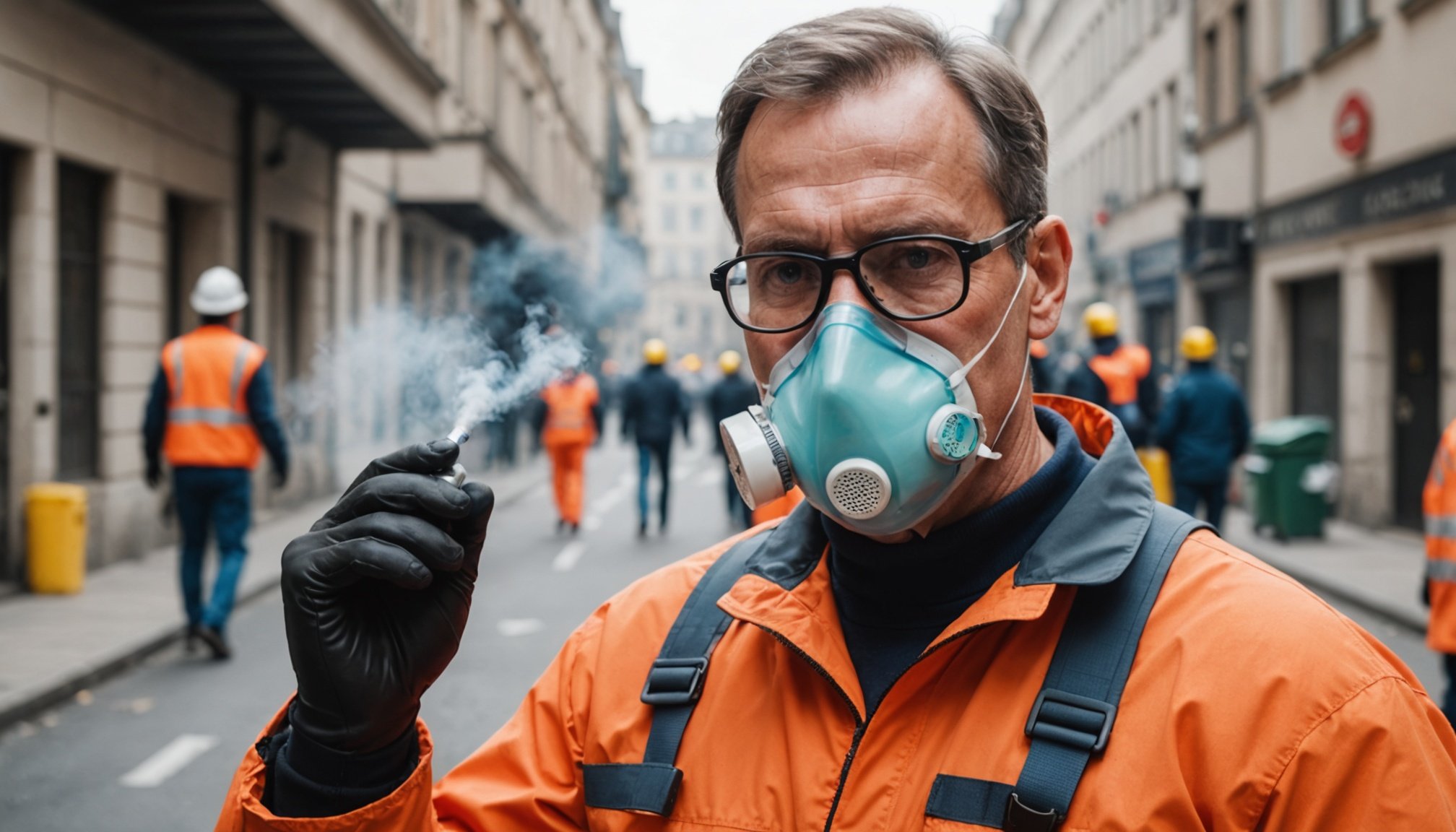Unveiling the Impact of Occupational Hazards on Chronic Obstructive Pulmonary Disease: What You Need to Know!
Understanding Chronic Obstructive Pulmonary Disease (COPD)
Chronic Obstructive Pulmonary Disease, or COPD, is a progressive lung disease that affects millions of people worldwide. It is the third leading cause of death globally, responsible for 3.23 million deaths in 2019 alone.
What is COPD?
COPD is an umbrella term that encompasses several long-term lung diseases, including chronic bronchitis and emphysema. These conditions inflame the airways and block airflow, making it increasingly difficult to breathe. Chronic bronchitis affects the bronchial tubes, causing ongoing irritation and swelling that damages the tubes’ hair-like structures (cilia), while emphysema damages or destroys the pulmonary air sacs (alveoli), impairing the exchange of oxygen and carbon dioxide.
In the same genre : How can educational campaigns effectively promote vaccine uptake in communities?
Symptoms of COPD
The symptoms of COPD can be subtle in the early stages but become more pronounced as the disease progresses. Common signs include:
- Persistent Cough: Often producing a significant amount of mucus, this is frequently referred to as a “smoker’s cough” and is associated with chronic bronchitis.
- Shortness of Breath: This is one of the most significant symptoms, typically not occurring until later in life, and is associated with emphysema.
- Noisy Breathing: Wheezing, whistling, or squeaking sounds during breathing are common.
- Chest Tightness: Feeling like you can’t take a deep breath or experiencing pain while breathing fully.
- Increased Fatigue: Reduced oxygen supply to body tissues can lead to easy fatigue or constant tiredness.
The Role of Occupational Hazards in COPD
Occupational hazards play a significant role in the development and exacerbation of COPD. Workers in various industries are exposed to a range of harmful substances that can damage lung function over time.
Also to read : Exploring the Effects of Music on Alleviating Anxiety in Patients Prior to Surgery
Common Occupational Hazards
- Dust Exposure: Workers in mining, construction, manufacturing, and other industries are at high risk due to exposure to silica, coal dust, and other minerals. Silica dust, for example, can cause silicosis, which can lead to COPD and even lung cancer.
- Silicosis: This condition results from the accumulation of silica dust in the lungs, leading to the formation of fibrous tissue and nodules that distort and damage lung tissue.
- Coal Workers’ Pneumoconiosis (CWP): Also known as “black lung disease,” this is caused by long-term exposure to coal dust and can lead to severe disability and secondary heart failure.
- Chemical Fumes: Exposure to welding fumes, aluminum dust, lead, and benzene can significantly impact lung function. A study found that workers exposed to these substances had higher rates of lung function abnormalities.
- Air Pollution: Chronic exposure to air pollution, including secondhand smoke, is another major risk factor for COPD. This can slow lung development, especially if exposure occurs during childhood or adolescence.
Risk Factors and Prevention
Understanding the risk factors associated with COPD is crucial for prevention and early intervention.
Key Risk Factors
- Smoking: The primary cause of COPD, with about 75% of cases occurring in people with a history of smoking.
- Secondhand Smoke: Exposure to secondhand smoke, especially during childhood or adolescence, can increase the risk of COPD.
- Asthma: A history of asthma can also increase the risk.
- Air Pollution: Chronic exposure to air pollution is a significant risk factor.
- Occupational Exposure: Exposure to dust, chemical fumes, and other occupational hazards.
Preventive Measures
- Job Rotation and Protection: Policies to limit the duration of dust exposure and provide job rotation and protection for workers with long-term exposure can help mitigate the risk.
- Personal Protective Equipment (PPE): Ensuring workers use appropriate PPE, such as respirators, can significantly reduce the risk of inhaling harmful substances.
- Regular Health Check-ups: Regular health examinations can help in early detection and management of lung function abnormalities.
- Public Health Initiatives: Strict regulations and public health initiatives to reduce air pollution and exposure to harmful substances are essential.
The Impact on Lung Function
Occupational hazards can lead to significant changes in lung function, resulting in various types of pulmonary dysfunction.
Types of Pulmonary Dysfunction
- Obstructive Pulmonary Dysfunction: Characterized by airflow obstruction, this is common in COPD patients.
- Restrictive Pulmonary Dysfunction: This involves a reduction in lung volume, often seen in conditions like silicosis and asbestosis.
- Mixed Pulmonary Dysfunction: A combination of obstructive and restrictive patterns can occur, especially in workers exposed to multiple hazards.
Long-term Effects
- Lung Damage Accumulation: The long-term and gradual impact of occupational dust on the human body results in the accumulation of dust in the lungs, leading to continuous damage to lung tissue.
- Reduced Lung Tissue Elasticity: With age, the elasticity of lung tissue decreases, exacerbating the effects of dust accumulation and leading to further lung damage.
Real-Life Examples and Case Studies
Understanding real-life scenarios can provide valuable insights into the impact of occupational hazards on COPD.
Coal Workers’ Pneumoconiosis
- A study on coal miners revealed that between 1970 and 1974, the prevalence of CWP among US coal miners who had worked over 25 years was 32%. This prevalence decreased to 9% in 2005-2006, highlighting the importance of regulatory measures and protective equipment.
World Trade Center Lung
- The aftermath of the September 11 attacks saw a cluster of diseases known as “World Trade Center lung,” which included conditions like asthma, asthmatic bronchitis, and terminal airways disease. This highlights the immediate and long-term effects of exposure to harmful substances in occupational settings.
Practical Insights and Actionable Advice
For individuals and employers, there are several practical steps that can be taken to mitigate the risk of COPD due to occupational hazards.
For Workers
- Use PPE: Always use recommended personal protective equipment when working with hazardous materials.
- Regular Health Check-ups: Ensure regular health examinations to monitor lung function.
- Report Symptoms: Early reporting of symptoms such as persistent cough or shortness of breath can lead to timely intervention.
For Employers
- Implement Safety Protocols: Establish and enforce strict safety protocols to minimize exposure to harmful substances.
- Provide Training: Educate workers on the risks associated with their job and the importance of using PPE.
- Promote Health Initiatives: Encourage regular health check-ups and provide resources for workers to manage their health effectively.
COPD is a serious and debilitating disease that can be significantly influenced by occupational hazards. Understanding the risks, taking preventive measures, and implementing safety protocols are crucial steps in protecting workers’ health.
Key Takeaways
- Occupational Exposure: Exposure to dust, chemical fumes, and other occupational hazards is a significant risk factor for COPD.
- Preventive Measures: Job rotation, use of PPE, and regular health check-ups can help mitigate the risk.
- Public Health Initiatives: Strict regulations and public health initiatives are essential in reducing exposure to harmful substances.
- Early Detection: Early detection and management of symptoms can significantly improve the quality of life for COPD patients.
By being informed and proactive, we can reduce the impact of occupational hazards on COPD and ensure better health outcomes for workers in high-risk industries.
Table: Comparison of Common Occupational Lung Diseases
| Disease | Causes | Symptoms | Long-term Effects |
|---|---|---|---|
| Silicosis | Silica dust exposure | Shortness of breath, reduction in vital capacity | Fibrous tissue formation, lung distortion |
| Coal Workers’ Pneumoconiosis (CWP) | Coal dust exposure | Shortness of breath, fibrotic reaction in terminal bronchioles | Progressive massive fibrosis, secondary heart failure |
| Hypersensitivity Pneumonitis | Inhaled organic dusts | Inflammation of alveoli, shortness of breath | Chronic inflammation, lung fibrosis |
| COPD | Smoking, secondhand smoke, air pollution, occupational exposure | Persistent cough, shortness of breath, noisy breathing | Airflow limitation, lung tissue damage |
Detailed Bullet Point List: Risk Factors for COPD
- Smoking: The primary cause of COPD, with about 75% of cases occurring in people with a history of smoking.
- Secondhand Smoke: Exposure to secondhand smoke, especially during childhood or adolescence.
- Asthma: A history of asthma can increase the risk of COPD.
- Air Pollution: Chronic exposure to air pollution.
- Occupational Exposure: Exposure to dust (silica, coal), chemical fumes (welding fumes, aluminum dust), and other hazardous substances.
- Age: Risk increases with age, especially after the sixth decade of life.
- Genetic Factors: Certain genetic conditions, such as alpha-1 antitrypsin deficiency, can increase the risk.
Quotes from Experts
- “The long-term and gradual impact of occupational dust on the human body results in the accumulation of dust in the lungs, leading to continuous damage to lung tissue.” – Study on occupational lung diseases.
- “Early detection and management of symptoms can significantly improve the quality of life for COPD patients.” – Respiratory care specialists.
- “Strict regulations and public health initiatives are essential in reducing exposure to harmful substances and mitigating the risk of COPD.” – Public health officials.
By combining comprehensive information, real-life examples, and practical advice, we aim to raise awareness about the critical impact of occupational hazards on COPD and encourage proactive measures to protect workers’ health.











